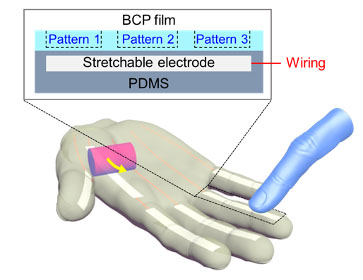| May 06, 2022 | |
Self-powered, 'one-terminal' tactile sensor for wearables |
|
| (Nanowerk Spotlight) Over the past few decades, researchers have developed a wide array of tactile sensors that form the basic platform of an artificial sensory system for fabricating robotic skins, prosthetics, haptic devices, and wearable or implantable devices. | |
| Examples include a highly sensitive flexible tactile graphene sensor mimicking human fingerprint, robotic electronic skin made from spray-coated tactile sensors, graphene touch sensors for wearable electronics, or skin-inspired haptic memory devices, to name just a few examples. | |
| "Several technological issues to produce practical tactile sensors have been intensively investigated and have seen remarkable advances in deformability, lightweight, sensitivity, and signal analysis and data feedback," Jin Kon Kim, a professor at Pohang University of Science and Technology and Director of the National Creativity Research Initiative Program for Smart Block Copolymers in Korea, tells Nanowerk. "However, low power consumption and simple device structure are still big technological challenges." | |
| Among the potential power sources for tactile sensors, self-powered high potential signal generation with a weak external stimulus from triboelectric nanogenerators (TENGs) and piezoelectric nanogenerators has been demonstrated; and, while promising, has also shown significant disadvantages. | |
| "In previously demonstrated triboelectric tactile sensors, each sensing pixel has been wired separately to the electrode pad of a control board," Kim notes. "However, using a large number of connecting wires is not desirable in the sense of structural simplicity because the sensor should be implemented in three-dimensional deformable body parts." | |
| To address this issue, Kim and his group designed a self-powered, 'one-terminal' tactile sensor that can distinguish various motions on a single electrode. They did this by using a thermoplastic polymer that can easily change the electrostatic signal in a selective area. | |
| They report their findings in Nano Energy ("Triboelectric UV patterning for wearable one-terminal tactile sensor array to perceive dynamic contact motions"). | |
| The thermoplastic polymer used by the researchers undergoes chemical structural change under the irradiation of UV light. With this material they fabricated a device in which the electrostatic signal increases in proportion to the UV irradiation time. | |
| To fabricate their sensor, the researchers embedded a stretchable bottom electrode made of silver flake in a thin polydimethylsiloxane (PDMS) substrate. Then they coated a BCP film on the substrate and irradiated it with UV light (254 nm) through a mask. Different times of UV irradiation were applied through the mask slits in order to control the triboelectric performance of the patterns. Since the UV irradiation did not induce topological change, the BCP film surface was smooth. | |
| The space between the UV patterns played an important role as a potential barrier between the UV-irradiated area and the non-UV-irradiated area, which confined the triboelectric charges within the patterns by preventing the surface diffusion of the charges. | |
| "We successfully fabricated a triboelectrically-patterned tactile sensor (TPTS) that generates various electrostatic signals through UV patterning with only one wiring on a single electrode," Kim says. "Because this concept can simplify complex circuit design, it would greatly contribute to large-area tactile sensors or artificial skin in the future." | |
 |
|
| Scheme of the wearable triboelectrically-patterned tactile sensor (TPTS) array. The patterns are made by UV irradiation on a thermoplastic block copolymer film. Only one signal terminal is used for TPTS. Dynamic touch motions can be captured when the TPTS is placed on a palm. (Image courtesy of the researchers) | |
| As the team demonstrates in their paper, the simple structured TPTS array could perceive the position and the sequence of touches, shape of touching objects, and dynamic motions (sliding, rolling) of an object. | |
| Because the team's novel method can greatly simplify the circuit design of the tactile sensor, it can be applied as a basic platform for large-area sensing in artificial sensory systems such as robotic skin, prosthetics, haptic devices, and wearable/implantable devices. | |
| Although they have verified the reliability of the TPTS signal and reduced internal noise through grounding, the researchers still need to completely eliminate motion artifacts that are common in wearable sensors. Decoding based on artificial intelligence, which is being developed in recent years, will be a candidate to solve this problem. | |
| "In order for self-powered tactile sensors to be commercialized as wearable devices or artificial sensory systems, it is necessary to introduce a high-resolution, miniaturized version of tactile sensor," Kim concludes. "Although our TPTS solves circuit design challenges, fabricating high-resolution miniaturized TPTS sensors remains a challenge." | |
 By
Michael
Berger
– Michael is author of three books by the Royal Society of Chemistry:
Nano-Society: Pushing the Boundaries of Technology,
Nanotechnology: The Future is Tiny, and
Nanoengineering: The Skills and Tools Making Technology Invisible
Copyright ©
Nanowerk LLC
By
Michael
Berger
– Michael is author of three books by the Royal Society of Chemistry:
Nano-Society: Pushing the Boundaries of Technology,
Nanotechnology: The Future is Tiny, and
Nanoengineering: The Skills and Tools Making Technology Invisible
Copyright ©
Nanowerk LLC
|
|
|
Become a Spotlight guest author! Join our large and growing group of guest contributors. Have you just published a scientific paper or have other exciting developments to share with the nanotechnology community? Here is how to publish on nanowerk.com. |
|
